 English
EnglishAsia Pacific
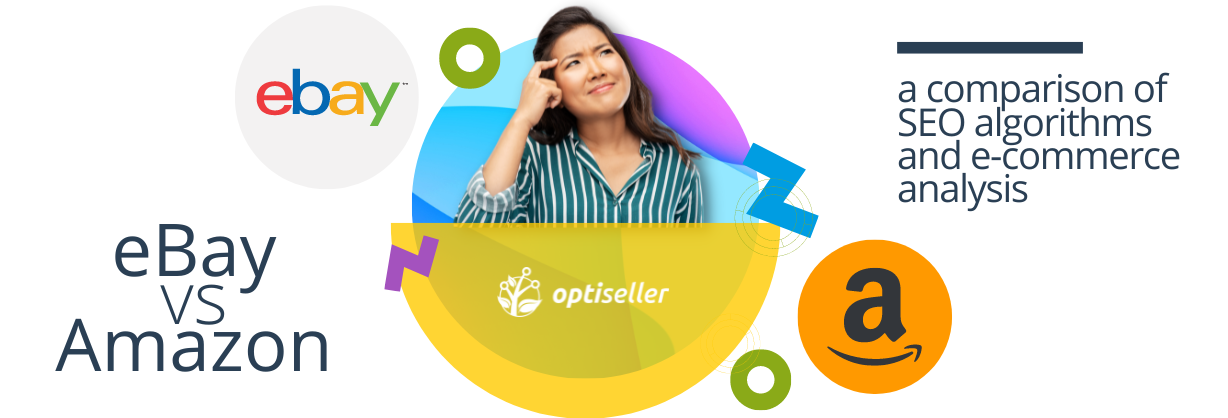
Ah, the age-old e-commerce question we all ask ourselves: should I sell my products on eBay or Amazon?
These two are top online marketplaces and popular amongst both sellers and buyers. And no wonder they are the two highest ranking e-commerce websites worldwide, these are clearly the (virtual) places to be. However, deciding which one is suited best for your selling needs is not so simple. There are loads of aspects to consider before venturing to one (or both) of the sites to sell.
![]()
At first glance, both companies show impressive stats that will be sure to make your head turn.
| eBay | Amazon |
|---|---|
| 109 million buyers | 310 million buyers |
| 19 million sellers | 9.7 million sellers |
| 2021 TTM revenue: $10.3bn | 2021 TTM revenue: $470bn |
| 109 global markets | 20 global markets |
Impressive, indeed. But sprouting out big numbers on traffic, revenue and global markets isn’t what’s important when deciding the needs of your business. Getting to the nitty gritty details of each company’s operations, regulations, customer demographic and most importantly, Search Engine Optimisation (SEO) ranking algorithms, is what should determine your decision on where to list your products.
Let’s dive a little deeper into the cogs of these e-commerce platforms through a comparison of SEO algorithms and business analysis.
![]()
![]()
We’ll be discussing in more detail:
Overview of Business Models
The major difference between eBay and Amazon is their business models. From Amazon’s beginnings in 1994, the company has always been a catalogue-based e-commerce site; with a combination of their own brands and products from third-party sellers. All listings on the site are fixed priced.
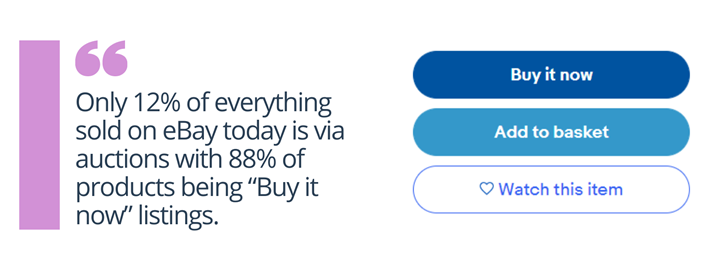
eBay, on the other hand, started out as an online auction-based marketplace in 1995 and has since moved to a mix of both auctions and fixed-price listings. In fact, contrary to what people might think, only 12% of everything sold on eBay today is via auctions with 88% of products being “Buy it now” listings. Unlike Amazon, eBay doesn’t have their own branded items, which means listings come from third-party sellers only. This could be an advantage to eBay sellers as they do not have to compete with eBay themselves. Whereas Amazon sellers not only have other third-party sellers to compete with, they also have Amazon’s products and prices. ![]()
Buyer Demographics
There are some interesting statistics involving the makeup of eBay and Amazon buyers. Firstly, knowing the platform traffic demographics is important in making your decision where to sell – taking into account your business location and other factors such as inventory categories and price. And most importantly, getting to know who your customers are will help establish which platform is right for your business.
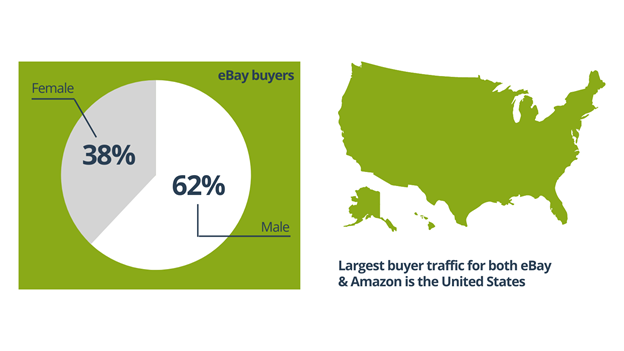
When it comes to gender, nearly 62% of buyers on eBay are male. It’s more evenly split on Amazon, although one study showed Amazon's typical shopper is a college-educated married woman – so perhaps it sways more towards females. If we look at the age group of the two platforms, both are similar – 53% of Amazon users are 19-44 with eBay’s largest age group being 18-24, closely followed by 25-34. Both eBay and Amazon also have buyer location in common, with the largest buyer traffic coming from the United States.
![]()
Buyer Psychology
We all know psychology plays a big role in consumer behaviour. So, it’s important to understand why buyers flock to one marketplace over another and how their perceptions influence their decisions.
Overall, 66% of consumers start their product searches on Amazon – which from the get go, gives sellers there a head start. Not only are there stricter rules sellers must adhere to, but Amazon has made returns easier and refunds guaranteed – all creating trust and security for the buyer.
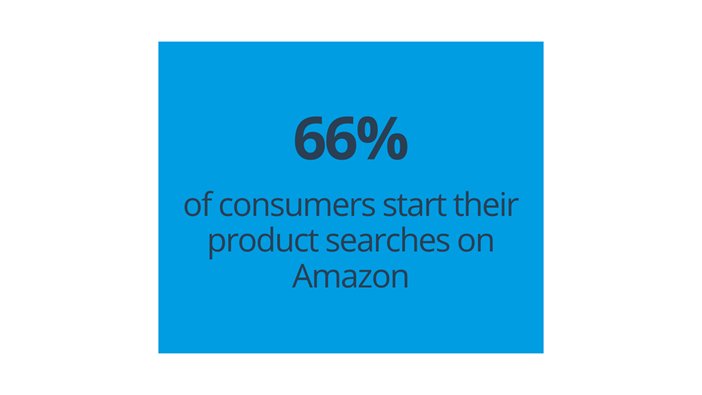
![]()
The top motivation for Amazon shoppers is fast and free shipping; whereas it is all about price point and unique products for those shopping on eBay. This correlates with the analysis of top categories shopped for by eBay and Amazon buyers. The top category sold on Amazon is in home and garden. This would make sense with motivation. Most people shopping for home improvement products will not want to spend a fortune on shipping but will also want their items sent as quickly as possible. So if furniture and garden accessories are what make up your inventory, you might want to try listing here first. However, it is also worth noting that eBay promote their sellers who offer free shipping, which is a positive incentive to selling on that marketplace.

eBay’s top category, on the other hand, is electronics and accessories so items such as mobile phones, computers and tablets are possibly best listed here. Again, this correlates with motivation of price point as it will be important to those looking for new electronics. This is not, however, an exact science, and buyer demand and motivation along with popularity of categories are fluid and can easily change over time.
It’s important to bear these points in mind when looking where to list your products. Both platforms are the perfect place to sell in bulk and scale your business and brand quickly. However, for those that sell niche and unusual products, perhaps collectibles and antiques, eBay is the option for you. The selling platform even has its own category for weird and unusual items.
SEO & Algorithms
Like with any online platform, adapting Search Engine Optimisation (SEO) keywords and content is what boosts traffic and ultimately, conversions. So when listing on e-commerce sites such as eBay and Amazon, you must pay close attention to your SEO optimisation and understand how the site’s algorithms work. Item Specifics like descriptions, images, price, shipping, speed and, very importantly, trustworthiness all come in to play when ranking on their sites.
eBay
eBay uses an algorithm called Cassini. It is essentially a ‘Best Match’ algorithm that determines which listings rank higher in the search engine. It takes into consideration many factors, including price and demand of the product, quality of the description and number of images displayed as well as time left to bid within auction-style listings. Feedback scores and level of customer service is of upmost importance if you want to be ranked high. eBay has seller levels and performance standards and assesses seller performance on the 20th of each month. From this, sellers are assigned one of the following levels which will affect your SEO performance:
The cool thing about eBay is that it gives sellers a lot of control when it comes to listing their products and choosing descriptions – making SEO a bit easier than Amazon; but with this control comes the responsibility of not only completing all required and relevant fields, but choosing the appropriate categories and item specifics to increase traffic and sales on eBay.
Amazon
Amazon’s algorithm, A9, is different to that of eBay. It is all about trying to win the “Buy Box,” not just getting higher up in the search engine ranks. Many of the requirements for better SEO are similar to eBay, for instance, description, quality, pricing, and customer reviews. However, the main influence for your Amazon store’s health is returns and refunds. Amazon also prefer the perfect product title – making sure the product brand, features, colour, sizing and quantity are included within the title. And don’t forget about ISBN/EAN numbers, these are required in every listing.![]()
There are elements to SEO that differ to that of eBay and can make getting in front of buyers a bit trickier. If you are a reseller, for instance, your product might get grouped in with another listing’s offer and you only have control of changing your description if you own that Buy Box. Complicated, we know.
Amazon will also give preference in ranking to those selling via Fulfilment By Amazon (FBA). You will learn more about FBA in the next section of this article.

Shipping & Fulfilment ![]()
eBay
Fulfilment services are a fairly new territory for eBay and is still not one hundred percent available to all sellers in all countries. There are several programmes eBay offers depending on the country you are selling from. So it is best to check what services are offered in the country you are selling from. Below are two of eBay’s biggest programmes to choose from:
The Global Shipping Programme makes your products available to over 60 million buyers worldwide. Not only that, you can choose which items to send through the programme and you are protected from negative and neutral reviews. All that is required is for you to send your items to the designated shipping centre in your country and eBay will then do the rest! However, not all sellers can use this service. You must have a seller rating of Above Standard or higher to qualify. Make sure to check all other criteria to see if you are eligible.
The eBay Fulfilment by Orange Connex has only just recently rolled out in certain participating countries. Orange Connex, who is a technology led fourth party logistics provider (4PL) for e-commerce marketplaces, has teamed up with eBay for sellers’ entire fulfilment needs. This service provides the whole package of end-to-end management of your products as well as protection against issues like delivery related defects. Within this service you will benefit from same day handling, late cut off times and the option of next day and standard delivery.

Amazon
Fulfilment by Amazon is a service provided to sellers which includes everything from storage to packaging and shipping, returns and refunds. It’s everything you need bundled together in one programme. An added bonus to this service includes eligibility for your products to be under Amazon Prime, which offers fast, one-day delivery on millions of items. With everything, it comes with a cost, which we will focus on in the next section. The FBA has four special programmes to choose from:
It’s important to determine whether one of these FBA programmes is right for you by weighing up the type and volume of your products, the quantity sold monthly and overall needs of the business.
![]()
Seller Fees
Seller fees are an important aspect to weighing up your options to sell on Amazon and eBay. As with any online marketplace, there are costs involved to hosting and selling your products. Thankfully, both platforms provide various options of programmes and services with either pay per sale or monthly subscriptions.
Amazon
Amazon has two plans available: individual and professional. Individual plans run at £0.75 (excl. VAT) per item sold plus additional selling fees. Or you can opt for the professional plan at £25 (excl. VAT) per month plus additional selling fees. Any serious seller will opt for the professional plan as this provides everything needed to run a successful Amazon account. There are other costs that may apply, including referral fees, inventory fees, high-volume listing fees, and refund administration fees. Fulfilment by Amazon has flexible rate structures so that you only pay for the services you use. These rates include a fulfilment fee (a flat fee per unit, based on the product type, dimension and weight) plus a storage fee which is charged per cubic foot per month. If you sell in large volume, it’s worth taking advantage of the professional plan.

eBay
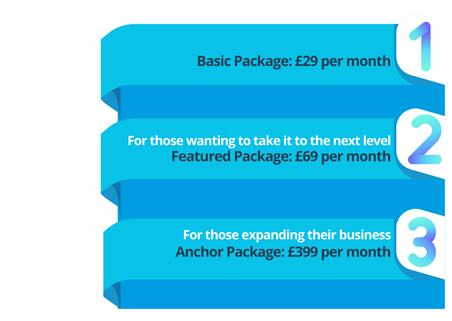
eBay has slightly more appealing prices, especially for smaller, individual private sellers.
Private sellers canlist for free on eBay. After your monthly allocation of 1,000 free listings have been used, you'll be charged 35p for each new listing created. Another perk for private sellers is only paying one final value fee for items you sell on eBay, nor do you have to worry about third party payment processing fees. There are, however, other fees that may apply if you add upgrades to your listing, or if international shipping is involved.
There is also the option to open your own eBay shop. This allows you to manage your inventory and grow your brand and comes with a load of benefits including access to eBay marketing tools, a customisable shopfront and unique URL and much more. There are 3 shop packages to choose from: Basic (£29pm), Featured (£69pm) and Anchor (£399pm); again, giving you flexibility depending on the volume you sell and needs of your company. Please note, you can have a business account without a shop but you must have a business account to open a shop.
![]()
Advertising
The goal for all sellers is to drive traffic and increase sales and one way of doing this is through paid advertising. Amazon offers an array of advertising options, including ad products, brand shopping experience and ad tech. One option is Sponsored Products which are cost-per-click (CPC) ads that promote individual product listings on Amazon and offer automatic targeting. According to Amazon, by using Sponsored Products, sellers see a 40%+ increase in units ordered and 54%+ increase in glance views. Sellers can also run deals or offer vouchers to help increase conversion.
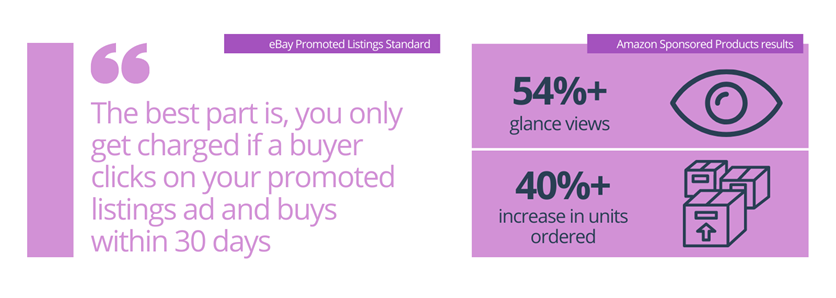
eBay offers Promoted Listings Standard, which is a self-service marketing tool that offers multiple sponsored placements across the eBay network. It’s pretty straightforward and the best part is, you only get charged if a buyer clicks on your promoted listings ad and buys within 30 days. The only downside is it’s not available to all eBay sellers or all categories, only those who are “Above standard” or a “Top-rated seller”, with enough account activity. eBay also offer Promoted Listings Advanced and Promoted Listings Express.
Global Expansion
We’ve already established that both online marketplaces have reached impressive global integration. But how easy is it for sellers to sell and expand international on eBay and Amazon? If comparing the two platforms, hands down eBay wins. All you need is just one account to start selling in 109 global markets and on 23 sites. You do not need to create an account for every eBay site in every country. eBay also has their eBay Global Shipping Programme, which assists in shipping your products internationally. So if you do not want to have a store on all sites, but still want to be able to ship your products globally, this is the perfect programme to use. All you have to do is ship your item to your country’s designated shipping centre and they take it from there including customs and imports!

Amazon, on the other hand, isn’t so simple. If you want to start selling in multiple countries, an account must be set up for each individual market. Because of this, it might get a bit tricky to not only keep up with costs, inventory, advertising and selling on Amazon, you’ll also have completely separate profiles that don’t talk to each other. Since your accounts don’t link, neither do your reviews – which could potentially hinder growing your brand locally and internationally.
Amazon does have services that help sellers integrate into new markets, including the Amazon Global Store, Seller Central Language Switcher, Build International Listings tool (BIL), and Amazon Currency Converter for Selling partners (ACCS). So, if you do not want to have to set up an account for every separate country, but still want to offer international shipping, one of these tools will do the trick.
![]()
Conclusion
Phew! We made it to the end! Who knew selling online could be so intricate? However, when done right, can also be very lucrative. That is why it is so important to spend time doing research into these online marketplaces. This article dove deeper into the workings of the two leading e-commerce sites in 2022 – with important highlights into the business models of both eBay and Amazon, along with the makeup of demographics and buyer psychology, overview of search engine optimisation and algorithms as well as shipping, fees, advertising and global expansion.
That’s a lot of information in one go, but we’ve only scratched the surface. There is a lot more to the world of e-commerce and how to be successful selling on online marketplaces, but hopefully you can now take with you a foundation to get started, or a refresher to those already selling. So, now it’s time for you to answer the age-old e-commerce question: will you sell on eBay or Amazon… or both?
![]()
One more thing...
Before you go!
Do you already sell on eBay or Amazon? We’d love to get your thoughts…
As a data-driven company here at Optiseller, we love (you guessed it)… coffee – wait no, we meant to say data. We love data.
So we’re really keen on diving deeper into this subject of selling on eBay vs Amazon to fully understand the mindset of e-commerce sellers.
To gather data on this topic, we’ve created a short survey. It will take you 5 minutes to complete, so you can get back to selling in no time!
Your responses are very helpful in the creation of a valuable report that will help other sellers find their e-commerce path and pave the way for growth in online marketplaces.
You can take the survey here: https://go.optiseller.com/sellersurvey

We look forward to sharing the final report with you.
Sources:
Sellics (source)
RepricerExpress (source)
eDesk (source)
eDesk (source)
Unamo (source)
JungleScout (source)
JungleScout (source)
Webretailer (source)
LandingCube (source)
Power Digital Marketing (source)
Investopedia (source)
eCommerce Bytes (source)
eBay (source)
Amazon UK (source)
Amazon US (source)